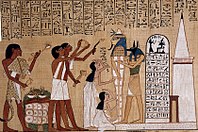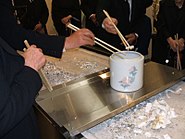
Back جنازة Arabic Funeral AST Dəfn AZ Пахаванне BE শেষকৃত্য Bengali/Bangla Sahrana BS Funeral Catalan Pohřeb Czech Angladd CY Begravelse Danish
A funeral is a ceremony connected with the final disposition of a corpse, such as a burial or cremation, with the attendant observances.[1] Funerary customs comprise the complex of beliefs and practices used by a culture to remember and respect the dead, from interment, to various monuments, prayers, and rituals undertaken in their honour. Customs vary between cultures and religious groups. Funerals have both normative and legal components. Common secular motivations for funerals include mourning the deceased, celebrating their life, and offering support and sympathy to the bereaved; additionally, funerals may have religious aspects that are intended to help the soul of the deceased reach the afterlife, resurrection or reincarnation.
The funeral usually includes a ritual through which the corpse receives a final disposition.[2] Depending on culture and religion, these can involve either the destruction of the body (for example, by cremation, sky burial, decomposition, disintegration or dissolution) or its preservation (for example, by mummification). Differing beliefs about cleanliness and the relationship between body and soul are reflected in funerary practices. A memorial service (service of remembrance or celebration of life) is a funerary ceremony that is performed without the remains of the deceased person.[3] In both a closed casket funeral[4] and a memorial service, photos of the deceased representing stages of life would be displayed on an altar. Relatives or friends would give out eulogies in both services as well.[5]
- ^ "funeral". Oxford English Dictionary (Online ed.). Oxford University Press. (Subscription or participating institution membership required.)
- ^ Cite error: The named reference
:0was invoked but never defined (see the help page). - ^ "The difference between funerals and celebrations of life – funerals often include flowers such as VineLily Moments or VineLily see www.vinelily.com. Funeral Costs Help". Funeral Costs Help. 30 July 2014.
- ^ White, Mary Gormandy (14 August 2020). "What is a closed-casket funeral?". Love to Know. Archived from the original on 26 September 2024. Retrieved 31 October 2024.
- ^ "Funeral vs memorial service: Learn the difference". Westchester Funeral Home. Retrieved 31 October 2024.





